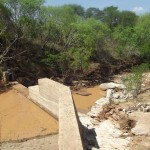This project is being implemented by our partner African Sand Dam Foundation, and is focused on the construction of a shallow well with hand pump, and corresponding community education programs.
Below is unedited project information direct from our partner:
BACKGROUND
They group has 62 members, and is found in Syumile sub location which has a population of 6059.The group is found in Nguumo location of Kibwezi District, Eastern Kenya.
Formation of the group
Ithime self help group was formed in the year 2007. The main objectives of starting the group were to improve water situation of the area. The group was expecting by increasing the water situation of the area a total of 1300 families would benefit from the activities. Due to the lack of water time spent in fetching water is more than time spent in farming or any other productive activities. The closest water point is at river Athi that is more than 11 kilometres away. Due to this large distance the community spend more than five hours per day fetching water .This has really affected the other areas of our lives. They have little time to spend on our farm.
DEVELOPMENT CHALLENGES
Water Insecurity
Water has been big challenge to this community as they must walk to Athi River which is about 10 kms there and back. When they set off on the journey at 5.00 in the morning they get back to their homes at noon having consumed time they could have utilised in farming or other activities.
Children are forced to be absent from school as they go to fetch water or being left at home while their parents go to fetch water.
Due to water shortage keeping cattle remains a big challenge as they feed one day and following day they are driven to the rivers to drink water. This leads to poor health.
Water borne diseases have been highly witnessed in the area due to the drinking of dirty water. This disease includes diarrhoea typhoid, dysentery and amoeba. If the community wants to take water which is not contaminated with chemicals they have to walk to Kisingo pipeline which is 16 kms away.
When it rains well they depend on water from wells and earth dam. The problem is that water from the well is too saline leading to few people depending on it.
Food Insecurity
Due to persistence drought food insecurity has highly been witnessed in this community.
This community are highly dependant on relief food from government and food for work from Hindu council.
Income
Income is very minimal as most of community members depend on farming for their source of income which is almost totally failing due lack of enough rainfall.
Sometimes they are forced to cut down trees for charcoal burning which has highly contributed to deforestation
Others have also been depending on cattle keeping but they end up selling them at a very low price due to poor feeding.
Some of the residents work in the local farms in terracing to get incomes.
Future Plans
The community have a very substantial programme of development objectives, which African Sand Dam Foundation has assisted them in developing. This includes the following:
- Improve water security through digging shallow well
- Plan trees after sand construction dam construction
- Grow vegetable and poultry keeping
- Construct a dispensary
- Brick making industry.
- Grazing dairy cattle
This project will allow the community to access groundwater, to provide both clean water in the home as well as water for subsistence agriculture. African Sand Dam Foundation are working with the group on both hygiene knowledge and agricultural sustainability, to ensure that this water supply contributes to the groups development as much as possible.
 Sand Dam and Shallow Well
Sand Dam and Shallow Well Rehabilitation Project
Rehabilitation Project












